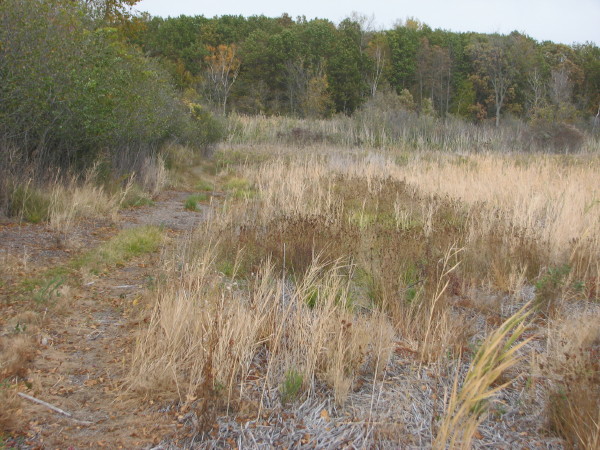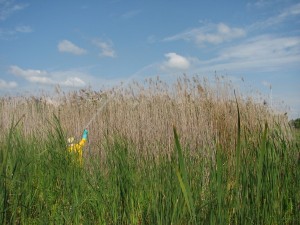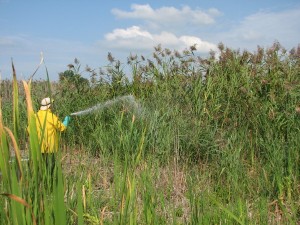May 18, 2015
Bob Williams, Phragmites.org
Some people believe that cutting invasive Phragmites helps it grow because the stand looks healthier; you see green growth, the brown dead material is all gone and the stand looks stronger than ever. In actuality, research shows that repeated cutting of the new green growth saps the strength of the plant and leads to a less dense, and shorter stand over time, though cutting alone cannot kill the plant. To make the stand smaller and weaker I always cut a dense stand of un-treated invasive Phragmites the winter prior to the first season of chemical treatment.
“Pre-cutting” is the process of cutting the old dead Phragmites in the winter or early spring before the first year of chemical treatment. The biggest mistake I made in my early management efforts was not pre-cutting a dense stand of Phragmites. At that time, pre-cutting was not considered by the large scale contractors or government agencies doing all of the management work, because helicopters and heavy equipment could easily access the whole site when spraying time came, and pre-cutting would have been an additional expense. In the fall, when I began chemical treatment of my first large tract of invasive Phragmites, I quickly found how difficult it was to access the infestation with the small scale equipment I had at my disposal: an ATV with a 24 gallon sprayer and a backpack sprayer. When I decided to treat a second tract the next year, I also decided to improve my access by pre-cutting the decades of old Phragmites during the winter before the first chemical treatment with a brush hog and tractor. The difference in results on the two tracts was amazing. In the first year of treatment in the pre-cut area I had about 95% control versus only about 70% control in the area I had not pre-cut.
The advantages of that first pre-cutting continued to show in future years of treatments on those two tracts. The pre-cut tract required only a few hours of follow up spot treatment on the individual stalks of regrowth. The tract that was not pre-cut has been a thorn in my side ever since. In the second year of treatment of that tract, I wanted to blanket spray most of the area again, however, I also wanted to be careful to avoid the spots where native plants were starting to return. However, there was no way I could hand treat two acres of Phragmites by myself, so blanket spraying was the only option. My personal concern with killing the native plants led me to a less than complete and effective spraying effort. To this day, that tract is the area of my property with the worst overall control results.
Pre-cutting was so effective because it got rid of the dead rigid stalks which had built up over decades, and had limited my access to the deepest part of the Phragmites stand. The chemicals that end up on the old dead stalks and leaves do not affect the live plant, so getting the dead material out of the way allowed the herbicide to reach the green portions of the new growth. The pre-cutting also results in shorter new growth to spray. When the old dead material is standing, the new growth has to compete with the tall dead stalks for sunlight, and year after year, the stand gets taller as it competes with its own dead stalks for sunlight. Pre-cutting results in shorter plants to spray, which makes it easier for any size sprayer to reach far into a stand of Phragmites.
If you are going to pre-cut a stand of invasive Phragmites you should do it before the first of June in the year you are going to do the first chemical treatment. I prefer to cut in January or February while the ground is frozen. Then by fall, there is a very fresh full stand of Phragmites, and plenty of green leaf surfaces to take in the herbicide. If you wait until spring to cut, you will be cutting new growth along with the old dead material. This will stress the plant a little, because it will need to re-grow new sprouts from nodes lower down on the plant, and will result in a stand that is appreciably shorter. You might choose to cut in May, instead of January or February, if you only have garden or backpack sprayers available for the fall chemical treatment.
The second most important cutting is in late fall, winter, or early spring following the first chemical treatment. You need to get that material out of the way for a good spraying the second fall. Very rarely is a cutting required after the second year of spraying. However, for aesthetic purposes many of us cut each winter anyway since it does not hurt the native wildflowers and grasses.

Returning native plants mixed in with Phragmites in the non-pre-cut area. Photo Credit: phragmites.org
I consider pre-cutting to be one of the most important steps towards a successful and complete control effort. Unfortunately due to the costs, government agencies and contractors rarely pre-cut, however, homeowners should do a pre-cut whenever possible. In my next blog I will discuss another option for homeowners which is not usually used on larger properties – multiple chemical treatments in a single season.


